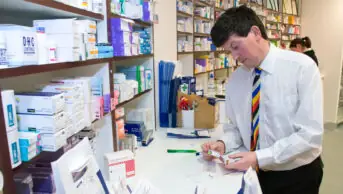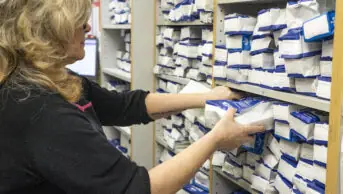
Shutterstock.com
After reading this article, you should be able to:
- Understand the importance of having a long-term vision and detailed plans when creating new services;
- Appreciate the role of the pharmacy team in creating clinical services;
- Display an understanding of the steps involved in developing a new clinical service.
As healthcare becomes more complex and the role of the pharmacist evolves, opportunities increasingly exist to create new clinical services. These could range from expanded provision, such as minor ailment schemes, point-of-care testing, contraception or pharmacogenomic testing, to the integration of new technology-enabled services designed to meet contemporary healthcare challenges in a modern and efficient way.
This article outlines five steps that can be followed when developing a new clinical service. It is based on experience gained from the creation of a paediatric hospital-at-home virtual-ward service in north west London.
1. Identify the need for a new clinical service
In the UK, ongoing pressures on both primary and secondary care highlight the need for a safe and effective buffer between the two settings and the prevention of avoidable hospital admissions. For example, according to the Royal College of Paediatrics and Child Health: “If we are to really improve outcomes for all children, we also need to consider whether some episodes of care could be safely and better managed without a visit to the emergency department or an admission to an inpatient ward.”[1] It encourages a greater emphasis on the use of ambulatory clinical services, avoiding hospital admissions and providing care in the community.
The ‘NHS long-term plan’ sets out a whole-system approach to delivering care, one that envisages integrated care systems that provide care closer to home, and empowered communities that self-care when safe to do so, with access to specialist care responsive to the needs of population groups[2]. The same-day emergency care model outlined in the ‘NHS long-term plan’ has been developed over decades by acute paediatric teams, with good use of ambulatory care for children[2].
Many children who present to the paediatric emergency department with acute illnesses, such as mild breathing difficulties, diarrhoea, vomiting and fever, could actually be managed at home. ‘Hospital-at-home’ care pathways for children have been developed over the past decade by nurse-led teams. They provide consistently safe outcomes and are of high value and quality for the children and families they serve.
Nationally there are already two services in place to reduce patients admitted overnight, lower re-admission rate, reduce length of stay and improve patient education:
- Same-day emergency care — acute paediatric teams have already developed this through ambulatory care;
- Virtual wards — part of NHS England’s national priorities and operational planning.
We identified that a new service could combine both these services to treat paediatric patients closer to home, resulting in the creation of PATCH (‘Providing Assessment and Treatment to Children at Home’). By providing ambulatory care, PATCH aimed to help achieve the vision of the ‘NHS long-term plan’ by relieving pressure elsewhere in the hospital and freeing up beds for paediatric patients who need admission either for emergency care or for a planned operation[2]. The long-term plan also highlighted that those patients discharged home with support have the best outcomes compared with those discharged home with no support[2].
The PATCH service uses a traffic-light system in line with National Institute for Health and Care Excellence guidelines to provide evidence-based care, aiming to reduce re-attendance rates, admissions and length of stay. Moreover, the PATCH service contributes to reducing the healthcare system’s carbon footprint by minimising the need for patients to travel to the hospital and reducing the number of hospital bed days required.
The NHS in England is responsible for around 20 million tonnes of carbon dioxide emissions annually and spends over £50m a year on carbon permits[3,4]. It is recognised that a fundamental transformation in service models will be needed and services based closer to the home may be one way in which the carbon footprint can be reduced[4].
The following reasons help support the development of beneficial services for paediatric patients:
- Providing a safe and effective link across existing primary and secondary services;
- Reducing paediatric emergency department attendances and re-attendances;
- Avoiding admissions and reduce length of stay for moderately unwell children, while always ensuring it would be safe to keep them at home;
- Improving and empowering parental confidence in self-care for mild and moderate illnesses.
Furthermore, these services can also contribute to skill development:
- Developing and delivering an innovative and truly integrated high-quality service that has been co-designed by staff working across the paediatric urgent and emergency care system;
- Recruiting, developing and retaining advanced acute paediatric nursing talent.
2. Engage pharmacy teams
Pharmacy engagement is integral to the success of any new clinical service that involves medicines. Failure to engage pharmacy teams early in the process can lead to problems occurring as the service develops. Pharmacists are well placed to lead clinical services because of their extensive knowledge of medications, ability to collaborate with healthcare teams and expert knowledge of clinical governance.
In the case of the PATCH service, the lead paediatric pharmacists across the four sites were integral and were involved in:
- Ensuring appropriate clinical governance pathways were in place;
- Ensuring safe prescribing of medication (name of medication, dose, frequency, route of administration);
- Ensuring safe administration of medication;
- Creating medication stock lists for the new service;
- Reviewing relevant patient group directives;
- Reviewing the patient referral form and flow chart;
- Creating standard operating procedures for IV administration;
Lead paediatric pharmacists were also involved in the creation of antibiotic administration charts, which contained the following:
- Prescription (name of medication, dose, frequency, route of administration);
- Administration record;
- Administration of IV antibiotic;
- Care of cannulas and infection prevention and control;
- Emergency treatment (e.g. if a patient experiences anaphylaxis to an antibiotic).
3. Develop a business case and set up funding
To get funding for a new service, a business case must be prepared. A pharmacy business case is a proposal that outlines the rationale and financial justification for implementing or expanding a pharmacy service within a hospital. It typically includes information about the need for the service, the potential benefits, estimated costs, revenue projections and a detailed implementation plan.
The process to approve a pharmacy business case in a hospital will vary depending on the individual hospital’s policies and procedures. A business case for resources needs to consider all aspects of the service, from prescribing to supply to administration to clinical assessments to follow-up care.
In the case of PATCH, hospital statistics played a vital role in submitting a robust case for resources and being able to demonstrate the resource needed and the impact the PATCH service would have on paediatric services. The budget needs to cover all aspects of the service to ensure sustainability and robustness in the project.
4. Engage stakeholders
It is essential that stakeholders are involved in the development of a service to ensure it has the backing of the trust and all the staff involved. The Collaborative Working Relationships Cluster in the RPS Advanced Pharmacy Framework states that collaborative working is a core part of professional development for pharmacists[5]. For PATCH to be successful, it needed pharmacists to engage and work with stakeholders. For example, it needed buy-in from the paediatric consultants in paediatric emergency department and on the paediatric wards: the lead clinician needed to allocate the resource for a doctor to prescribe the medication and to receive referrals from the PATCH nurse if a patient should deteriorate or blood cultures come back positive, and the chief pharmacist needed to allocate pharmacy resource to ensure prescribing was safe and within the remit of the service.
PATCH also required good communication between primary and secondary care, through agreeing antibiotic administration charts, dispensing and labelling of medications and being a source of contact for any medication-related questions.
By working within an integrated care system (ICS), pharmacists were able to collaborate, develop existing relationships and learn from each other.
5. Evaluate the service after implementation
After implementing a service, it is crucial to conduct reflective analysis to determine whether the service is delivering the expected benefits and to identify areas for improvement. Robust data evaluation, coupled with the ongoing measurement of key performance indicators, help reduce unwarranted variation and enable articulation of the quality impact across all its domains (safe, timely, effective, equitable, efficient, patient-centred) and ensures service developments are driven by outcomes. Data analysis provides quantitative and qualitative proof of the impact of such a service on the hospital and patients.
Monthly PATCH governance meetings were scheduled, which included pharmacists, nurses and doctors. These provided an opportunity for shared learning and resources and a forum to discuss any challenges the service faced. Cross-collaboration between pharmacy teams across the North West London Integrated Care System has been a major factor in the success of PATCH. Leadership is distributed across PATCH, rather than being in the hands of one department or discipline, and so PATCH includes paediatric pharmacists who work as clinical leaders through collaboration and innovation.
We evaluated the service by asking patients and their families for feedback on the service. The service’s friends and family test has had a 100% response rate and a 100% recommendation rate in the past 12 months.
Reflecting on PATCH
PATCH started as a pilot project and has since evolved to an ICS-level service. The service highlights the benefits of collaborative working and having strong drivers for change.
Successes and challenges
PATCH has demonstrated significant progress. It began at one trust in the North West London ICS, and now all four trusts provide this service. The data shows care is high quality, family oriented, and reduces hospital stays. The feedback from families has been extremely positive (see Box).
Box: Feedback from families
“I’m a single parent to two children, having the access to the PATCH team and not having to stay on a ward or having to travel into the hospital every day for treatments for my young daughter was a life saver for me.”
“I only wish that more people could benefit from this incredible service, it makes all the difference seeing knowledgeable, kind professionals in the comfort of your own home.”
“Having had my first baby a few days ago it was extremely helpful for my wellbeing to be able to look after her at home rather than stay in the hospital.”
“This service gave us great peace of mind that we could care for her at home.”
“Very attentive, experienced nurse who really listened to my concerns and acted appropriately. Also lovely with my little boy when he was upset. Really appreciated being able to avoid returning to A&E for antibiotic”.
“Having the PATCH team available to my daughter meant that we could go home to recover and recuperate. I have two older children who have additional medical needs, who I could also attend to. This is an invaluable service when you have a poorly child. Being in the home my daughter recovered quicker. Having the team round to administer her IV antibiotics, they explained everything to me, results, prognosis, and any other questions I had. This team made an unimaginable situation, tolerable.”
However, starting the PATCH service has involved challenges. Articulating a pharmacy business case proved challenging when the financial benefits were felt in other parts of the system and took longer than in-year returns. In addition, complex commissioning and perverse financial incentives have hindered cross-system working and securing sustained funding.
Owing to pressures on pharmacy resources, there is a limited pharmacy service available at weekends to dispense medicines needed for PATCH. Discharge prescriptions for patients who have been identified for PATCH must be written as a priority to facilitate timely discharge.
Ensuring children and young people are kept on the wider urgent and emergency care agenda to ensure sustained funding and service development has been a wider challenge.
- This article was amended on 6 November 2023 to clarify that two services were in place nationally, not introduced by London North West University Healthcare NHS Trust
Acknowledgments
Thanks to Liza Evans, Katherine Bottomley, Nilakshi Joshi, Madeline Tyrell, Shanmugapriya Palanivelu, Rumina Hassan-Ali, Tristan Bate and Devangi Thakkar at Hillingdon Hospital for their support and guidance in establishing PATCH. Thanks also to Vishal Mehta, Sharmila Manorathan, Ami-Marie Morten, Kathleen Mills, Lauren Jade and the rest of the pharmacy department for their continuing hard work and dedication.
- 1Facing the Future: Standards for Children in Emergency Care Settings. Royal College of Paediatrics and Child Health. 2018.https://www.rcpch.ac.uk/sites/default/files/2018-06/FTFEC%20Digital%20updated%20final.pdf (accessed Oct 2023).
- 2NHS Long-Term Plan. NHS Confederation. 2019.https://www.longtermplan.nhs.uk/ (accessed Oct 2023).
- 3Delivering a ‘Net Zero’ National Health Service. NHS England. 2022.www.england.nhs.uk/greenernhs/wp-content/uploads/sites/51/2022/07/B1728-delivering-a-net-zero-nhs-july-2022.pdf (accessed Oct 2023).
- 4Sustainable Services: Future Trends. The King’s Fund. 2023.https://www.kingsfund.org.uk/projects/time-think-differently/trends-sustainable-services (accessed Oct 2023).
- 5APF Collaborative Working Relationships Cluster. Royal Pharmaceutical Society. 2013.https://www.rpharms.com/Portals/0/RPS%20document%20library/Open%20access/Faculty/APF%20-%20Collaborative%20Working%20Relationships%20cluster.pdf (accessed Oct 2023).


